#global vacuum truck market
Explore tagged Tumblr posts
Text
Global Vacuum Truck Market Size, Share, Growth ⅼ Forecast (2024 – 2032) | Renub Research
Global Vacuum Truck Market value is anticipated to be about US$ 3.11 billion by 2032. The CAGR for the industry from 2024 to 2032 is 6.53%. Renub Research said that it amounted to US$ 1.76 billion in 2023. Vacuum trucks are innovative machines that split, accumulate, and haul away soil and different particles. Their fundamental layout consists of a truck with an extensive series tank hooked to a…
View On WordPress
0 notes
Text
#Global Vacuum Truck Market Size#Vacuum Truck Market Competitive Analysis#Vacuum Truck Market Forecast#Vacuum Truck Market Share#Vacuum Truck Market Growth Trends
0 notes
Text
I Think Hypmic's Portrayal of Gender Roles is Kinda Refreshing: An Essay A.K.A. I'm Procrastinating on a Weekend Deadline :)
Hypmic's talking points on gender are hamfisted, corny, and melodramatic. "Maybe...we shouldn't have a wage gap," is not the hottest of takes. However, like most things in Hypmic, the writers have a lot more to say about gender and gender roles in the framing of the story itself that's much more nuanced. And honestly? It's kinda refreshing.
It's also something that went way over my head when I first became a Hypmic fan. Sure, I read manga and played Japanese video games--usually translated into English first--but I didn't have enough exposure to hundreds or thousands of pieces of untranslated Japanese media. I'm going to guess that most Hypmic fans don't either, which is totally fine and normal. We all exist within our respective cultural communities wherein we're bombarded with messages constantly telling us how to act, think, and speak. We tend to absorb these messages on subconscious levels and reflect them in the art we create and stories we tell, either by reinforcing them or challenging them. Thus, our stories don't exist in a vacuum, and divorcing stories from their cultural backgrounds can suggest the artist is the original thinker of a larger concept or hide their specific point of criticism. That is, if I wrote a story about a man who chooses to not catch fish, drink beer, and drive a Dodge Ram pick-up truck, we should be aware that I'm not the person who conceptualized the stereotype of dudes who catch fish, drink beer, and drive pick-ups. I wouldn't deserve the credit for dreaming up that exact image, and at the same time, it would be incorrect to read that as me targeting those three things randomly. The choice to not drive a Dodge Ram pick-up is not a commentary on Fiat Chrysler Automobiles. It's a stand-in for the notion of masculinity.
Thing is, we're hit with messages about masculinity, femininity, and other gender-related concepts on a daily basis. No matter where you live or what language you speak, every person on Earth is inundated with messages saying, "This is what you are, and consequently, this is how you should act." Our relation to these messages is complicated, and this complexity is compounded by different cultural communities preaching different messages in their stories, marketing, and human interactions. For instance, the US's massive global cultural influence means that those outside the US can still easily recognize what I mean by catching fish, drinking beer, and driving enormous American pick-up trucks. But the location and cultural differences may add or subtract nuances. A person living in, say, Munich is unlikely to have Dodge pick-ups advertised to them the way a person in rural Texas would. Our fictional Munich person does not feel the same social pressures to buy a Dodge and represent their masculinity with a Dodge the way our imaginary Texan would. In turn, the Munich person likely sees a Dodge with an element of absurdity--who the hell needs such a big truck in a European city?--and foreign Americanness. The Texan wouldn't have that concern--why worry about navigating your enormous truck down narrow streets when you live in the countryside?--and sees Americanness as their local default, thus removing any element of foreignness.
That is to say, gendered messages aimed at people (especially women) who live in Japan don't affect me the same way as they impact those who do live in Japan. Like, it's not my dog in the fight, and there are plenty of people who are directly affected who write their own stories and commentaries on gender roles in Japan. Japanese women don't need a random guy in the US to stand up and say, "Damn, your gender roles are fucked!" 1) They already know. 2) They're already saying it. So I come at this from an angle of someone who already has deep, primary frustration with the gendered messaging in my culture and secondary frustrations when similar messages appear in other cultures. I don't have a bone to pick with Japanese media in particular. Plain and simple, reading and working on hundreds of pieces of Japanese media is what I do for a living. It's in my face constantly, and as a result, I am also perpetually bombarded by messages about gender roles in Japanese media.
It's not a hot take to say that Japanese media, like the media of every single other culture around the globe, has a lot to say about gender. There's a lot of slotting people into boxes and telling people what to do. It's chafing, as we see all across history in art produced in reaction to gender roles. In the past couple of decades, global shifts in gender roles have caused media to shift the messages they're pushing, but it's not controversial to say that Japan has lagged behind other countries like the US.
Many, many stories push arbitrary notions of how to be a girl or how to be a boy that don't necessarily come from the author themselves. The authors probably aren't even fully conscious that they're making these choices. If an author writes a story about a library and makes every female character a romance fan and every male character an action fan, it's likely a reflection of endless messaging that says action is for boys, romance is for girls. In turn, this story becomes yet another reinforcing message. If no fictional girls like action, and no fictional boys like romance, it becomes alienating for real girls and boys who don't follow these same rules. These rules are everywhere and have so much to say about gender that it's hard to know where to begin. Girls must like cute things. Boys can't like sweet food. Women must not express sexual desire. Men can't be shy. On and on and on.
Which is why, when there's a relative lack of this in Hypmic, it's kind of a breath of fresh air.
Wrong Ways to Be a Man
Actually, Hypmic does have a few moments where characters claim there are certain things men or women should do, but the writing always frames these messages as incorrect.
Take Samatoki, for instance. After Kuukou and Sasara leave MCD, Samatoki tells Ichirou, "Men shouldn't cry when they lose their friends. Men should only cry when they lose a family member."
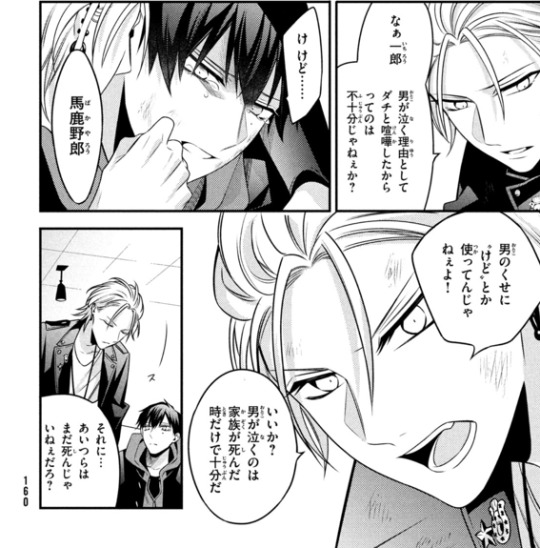
(TDD chapter 10)
This line usually appears via Ichirou's perspective. In the stage play, it's told during a song Ichirou narrates, and as shown above in panel 3, the manga frames the line from the angle at which Ichirou sees it. In such moments, the audience is meant to read this as a cool line from a strong mentor figure to Ichirou. That's how Ichirou sees it, and he's a seventeen-year-old with too much on his shoulders who idolizes Samatoki. He is incapable of seeing how much pain Samatoki struggles with.
However, when the manga focuses on more intimate moments of Samatoki's life, we see that Samatoki does struggle quite a lot.
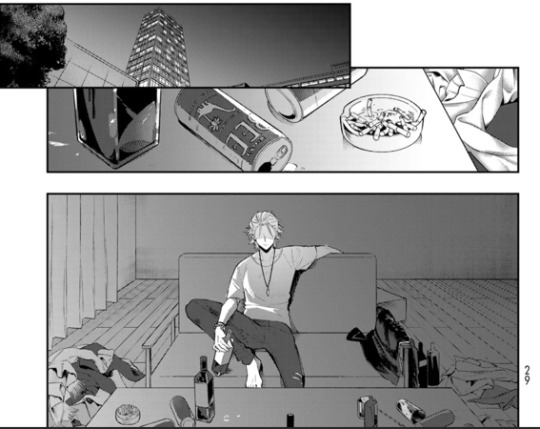
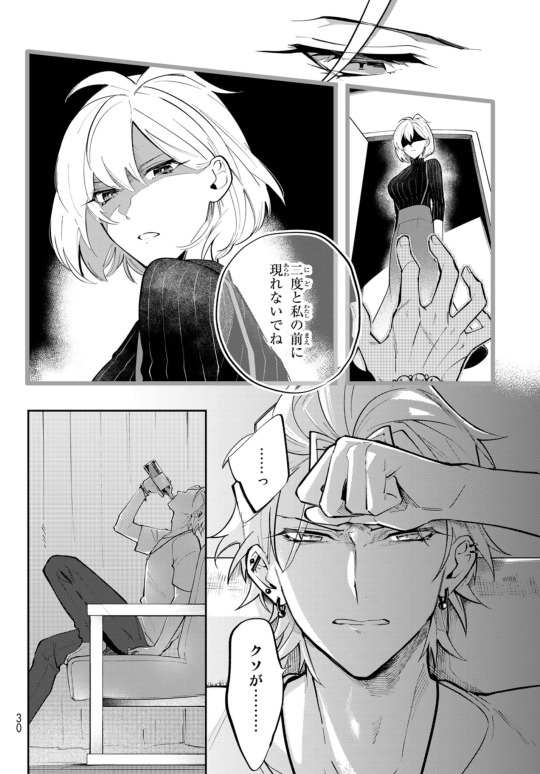
(BB/MTC+ chapter 6)
This isn't a cool, attractive figure meant to be idolized. While Samatoki's cigarette usage and aggressiveness are often framed as sexy or enticing, the juxtaposition with dirty laundry, overflowing ashtrays, and empty bottles make him a sympathetic and struggling figure. Therefore, we should understand that his notion that men don't cry is flawed. It's a means to distract himself from emotions he doesn't want to feel.
Later, as Samatoki begins to process his emotions and open up to his teammates, the unhealthy coping mechanisms recede. Samatoki is more confident, mature, and happier as a result of being more emotionally vulnerable.
We see a similar transformation with Kuukou. As a teen, Kuukou is reluctant to accept help or truly let anyone in. In a conversation with Hitoya, he says (and I am still completely unable to take this seriously), "A man's got to wipe his own ass."

(DH/BAT chapter 4)
However, over the course of his character arc, Kuukou learns that he cannot exist as a good leader or individual without the teamwork of his newfound "family." Only rejecting this classical and toxic notion of masculinity brings Kuukou joy.
In fact, most of the first-line characters have very similar arcs. At the start of the story, Ichirou is insistent on doing everything himself. He has to learn to be able to rely on other people (Kuukou, Samatoki, Ichirou and Jirou) to be happier and unlock his true strength. See below, his final attack and Ability use in the 2nd DRB, which is only possible when his brothers figuratively and literally support him through it.
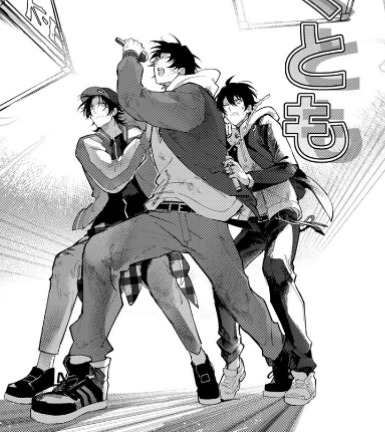
(BB/MTC+ chapter 25)
Sasara struggles with emotional honesty and trust in favor of using humor to gloss over discomfort. It takes multiple heart-to-hearts with Roshou before he can let humor take a backseat and say how he really feels. Ramuda has difficulty trusting other people and being honest with his emotions when faced with stressful scenarios. Only through Fling Posse is he able to open up and ask for help instead of driving people away when the problems are too big for him to face alone. Jakurai struggles to connect with other people, work through and acknowledge his complicated feelings, and not place himself on a pedestal. Through Matenrou, Jakurai is able to ask for help, be more open, and ultimately be less hard on himself.
The second- and third-line characters follow similar arcs, and this repetition creates a core message for Hypmic: Trust and rely other people. Be open with your feelings. There's a wrong way to be a man, and that's to hurt yourself and other people.
Right Ways to Be a Man...Are Infinite!
But with that being said, there is a surprising lack of commentary on how else to be a man. Hypmic as a whole doesn't do much to constrain the male characters in terms of gender roles.
Sure, some characters do fit into more traditionally masculine roles--Ichirou, Samatoki, Riou, etc. The messaging makes it clear that it isn't wrong to play into masculinity provided it doesn't become toxic. (See above.)
Even then, however, these especially masculine characters are associated with less masculine traits that are either portrayed positively or not portrayed as a joke. Riou is an avid cook, but the joke is never that he wears an apron and knows his way around an outdoor kitchen (tee-hee, men don't cook!). It's that he cooks with horrifying ingredients. Samatoki is a fashionista, but the joke is framed as a counterpart to Ichirou's nerdiness.
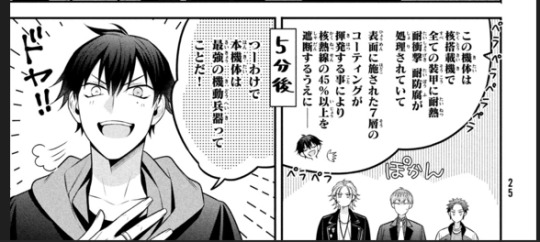
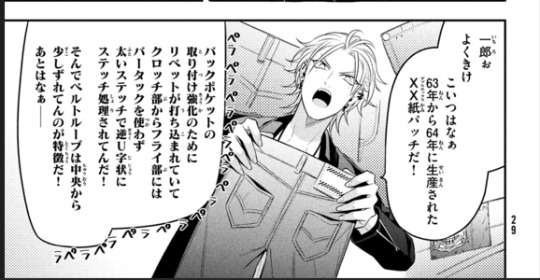
(DoD chapter 1)
Here, it's funny that neither of them can shut up (the ペラペラ/blah blah SFX, the long bubbles filled with lots of text that's cut to indicate they kept going for longer), but the object of their attention--a model toy and a pair of jeans--are treated in the same neutral light. It's very common for stories to touch on, even defensively, the social taboo of men being into clothes. Hypmic doesn't even acknowledge that such a taboo could exist.
This is subtle but extraordinarily effective in giving characters the same consideration and weight. The more feminine characters are always treated just as sincerely (or, if there's a joke to be made, irreverently) as the more masculine characters. Take Ramuda, for instance. In Japanese media, a love of sweets is often characterized as feminine and will often be remarked upon, even in LGBT+ media, as atypical for men. Again, there's zero acknowledgement of such a thing in Hypmic. Whenever other characters talk about Ramuda's food intake, it's always framed as a concern about the lack of nutrition.
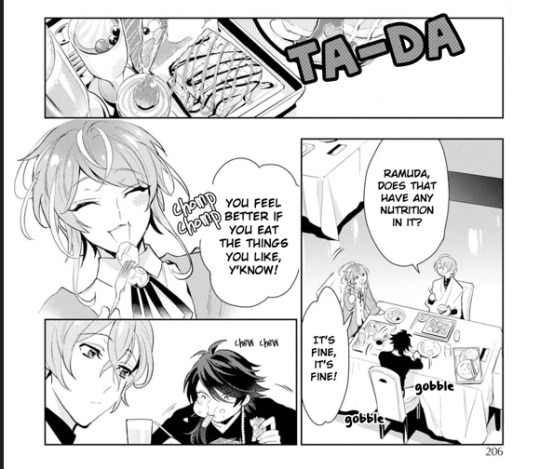
(FP/M chapter 11... I don't have the source lying around on my computer, so here's the old-ass scanlation lol)
It's also given the exact same weight as anyone else's junk food habits. Here, MCD goes out for burgers (a neutral to masculine-coded food due to the meat and high calorie count) while Ramuda opts to try a sugary Starbucks-esque drink. The parallelism in the comic's framing suggests that the two objects are functionally the same, and there is no comment that a sugary drink is feminine and therefore "inappropriate" for Ramuda. There's also no indication that MCD's preferences are in any way better. They simply happen to be the characters' personal preferences. The punchline is two groups splitting up, only to awkwardly run into each other again moments later.
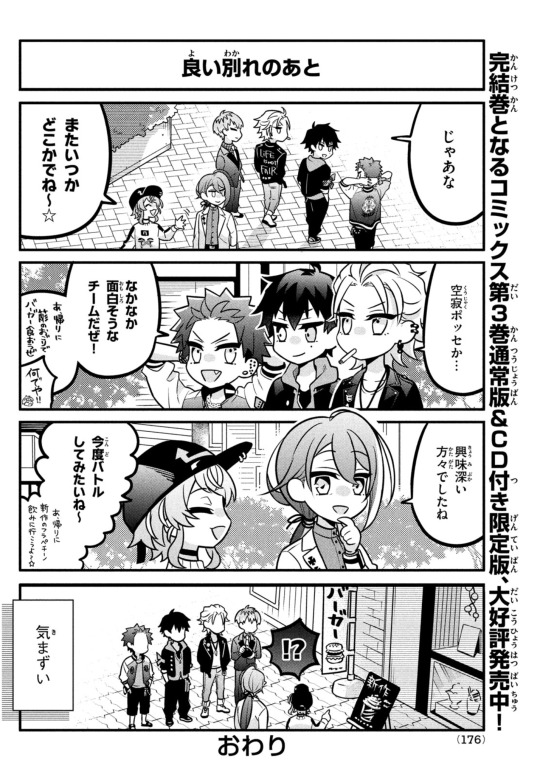
(DoD volume 4 bonus comic)
Similarly, Ramuda's interest in clothes or fashion is never treated negatively--in fact, the discussions of clothes as a means to find identity and happiness make it a positive!
In ARB cards and promotional materials, Ramuda sometimes wears dresses. It's, again, portrayed in parallel to other characters wearing more masculine clothes and is never commented on as something "unusual." It's just who Ramuda is.
Hifumi is another interesting case. Like Ramuda, his playful personality often doesn't as stereotypically masculine. (To be clear, I read much of this as "gender neutral with a strong emphasis on youth" versus "feminine" in a way that I'm not sure has a good US equivalent...metrosexual/yuppie men's fashion, maybe? In the sense that it's a youth subculture that defies some masculine gender roles but is still focused mainly on men. I wish I was more well-versed in Japanese men's fashion and could give an exact term, but I'm what I'm thinking of is definitely an established thing--young, trendy dudes whose styles focus on poppiness vs. the rugged manly man or "idk, I'm just some guy" subcultures. It's a thing that pisses off old Japanese conservative men in the same fashion as people getting up in arms about "the gayz!!!1!" and their androgynous clothing lol.) Their personalities are often the butt of jokes, but only in the same way that Dice or Doppo are--that is, that they're exaggerated and over the top. There's no commentary on masculinity or lack thereof.
There are also moments when Hifumi, Gentarou, or other characters play feminine characters in roleplay moments, which is usually (but not always) not the sole joke. The audience is supposed to find it funny, but the humor is almost always centered on the absurdity of the scene as a whole. For instance, in a moment where Hifumi and Doppo are pretending to be two drunk karaoke-goers, the humor comes from the composite set-up of Hifumi's hair twirl, Doppo's untucked shirt and tie, Doppo and Hifumi's exaggeratedly flirtatious poses, the spotlights and sparkles, and the same font as used on classic karaoke machines.
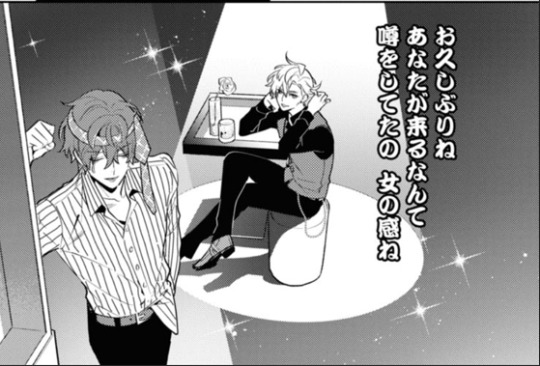
(FP/M+ September 2022 oneshot)
Hifumi and Doppo do not perform traditional gender roles in their homelife, and while it's easy to see and often commented on in the English-speaking fanbase when it comes to Hifumi, I find it just as prevalent on Doppo. It's true that Hifumi is taking a feminine role by doing the majority of the household's cooking and cleaning, but if we were to assume Doppo has the masculine role in the household, he would have the breadwinner duty. However, he isn't the main source of income for their household, and he's just as unassertive in finding a (female) romantic partner as Hifumi is. Japanese men are bombarded with media messages stressing the importance of taking an active role in career and romance. That Doppo does not would, in many stories, make him the butt of a joke for not living up to masculine gender roles. But he isn't; instead, Hypmic portrays him as a sympathetic character. It's tough, Hypmic says, for people to get good jobs and maintain friendships/relationships as an adult.
Similarly, it's noteworthy that Hifumi's self-appointed term "Gigolo" is consistently portrayed as a good thing in Hypmic. The meaning of the English term aside, the Japanese word ジゴロ (jigoro) is almost always used as an insult for a man who is financially dependent on one or multiple women. In the strictest sense of the term, Hifumi is a jigoro in that his income derives from his female clients. However, there is never any shame associated with that, and as a whole, Hifumi's career as a host is shown to be a positive thing. I can't express enough how rare that is in any sort of semi-serious media. Certainly, Hypmic acknowledges that his job requires too much drinking (Doppo's verse in Hoodstar), but the overall portrayal is overwhelmingly positive. Hifumi and his coworkers are never treated as uneducated, boorish, or pathetic for "failing" to find other work that does not require flirting with and entertaining women. (This is partially due to the overlapping judgment with sex work.)
All the various harmless preferences and personality traits of the male characters are treated equally with no judgement over what's masculine or non-masculine. Within the broader context of Japanese media, this absence of judgment stands out and reinforces one of Hypmic's core themes: Differences make us better, not worse. In the end, Hypmic suggests, there's no one right way to be a man.
Right Ways to Be a Woman...Are Just as Infinite!
But what about women? This series is, after all, marketed mainly towards women, and while female audience members can no doubt extrapolate the lessons learned from the male characters, it's worth taking a look at the female characters too.
The female characters do receive much less screen time than the men and are not the focus in the series; I'd argue that's less an issue of overt sexism and more that they fall out of focus in the story the writers want to tell. (There's a broader discussion to be had about inherent sexism in the writers' focus which goes hand-in-hand with rap industries across the globe favoring men and rap being an example of exaggerated masculinity, but that's a topic for another day.)
Even so, the framing of the female characters is interesting in a couple key respects. The individual character arcs and motivations of the main female characters are, in my opinion, some of the weakest parts of Hypmic--many times, Otome and Ichijiku do things because the plot demands them to, making them look incompetent or needlessly cruel for characters we're supposed to sympathize with. Nemu's story seems to be handled with more care and takes an interesting twist, wherein she openly acknowledges that she's disenfranchised as a woman in modern Japan but rejects the notion that she needs to find strength on either Ichirou or Samatoki's (male) terms. By choosing to be strong in "her own way" (whatever that means...it's not well-defined), the authors are using Nemu to reject the notion that strength and power are inherently masculine.
What I find to be far more interesting is the character design for the Chuuouku women, both in what is said and what is not said.
To begin with, the characters and their portrayals run the gambit from highly sexualized to completely non-sexual. Some characters (especially Ichijku and Honobono) have conventionally attractive, curvy body types and are often drawn in ways that highlight their bodies.

(FP/M+ chapter 4)
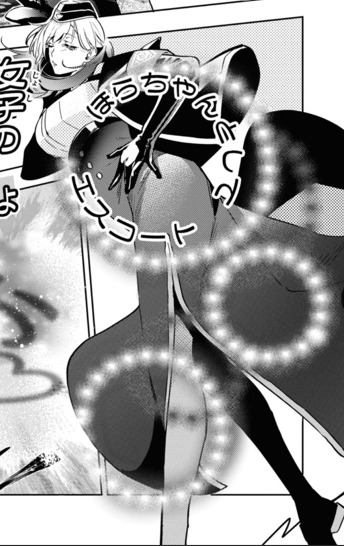
(FP/M+ chapter 14)
In some cases, especially Honobono's, the enticing nature of the illustrations is framed as the character's choice; in the above, her words indicate that she wants to seduce the off-screen listeners. The images included above are largely representative of these characters' raps, regardless of illustrator.
But on the flip side, other characters with large breasts or hips are never drawn in a sexual fashion. By way of comparison, here are two shots of Nemu rapping.
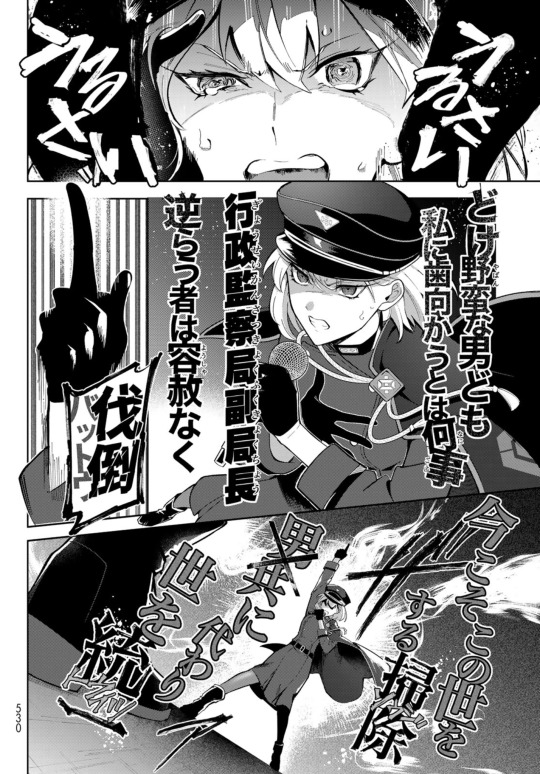
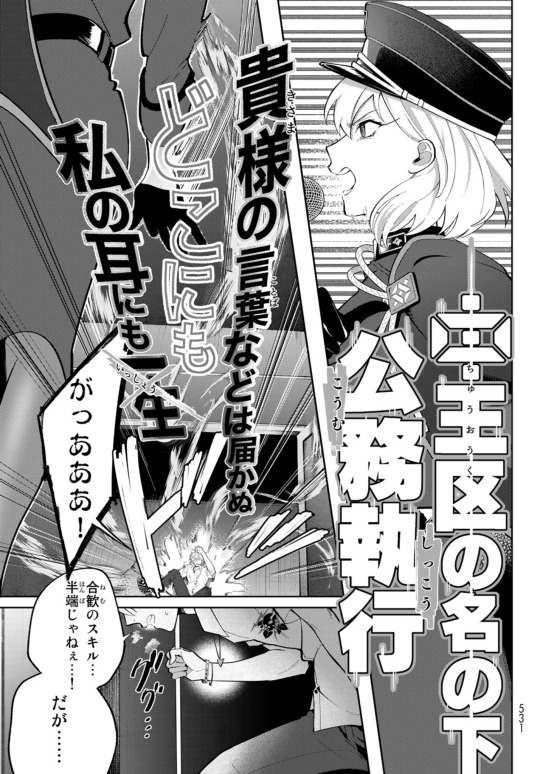
(BB/MTC+ chapter 12)
Even in shots with dynamic poses, no attention is drawn to Nemu's figure in any sort of provocative sense. Nemu touches her chest, drawing the reader's eye there, but the artist does not emphasize the size of her chest--they're allowing a chest touch to be no more than an emphasis of the self. At the same time, Nemu's body isn't downplayed. We can see in panel 2 on page 2 that Nemu has a small waist and wider hips, but once again, she isn't being sexualized. The action lines draw the reader's eye to Samatoki and thus put the action first and foremost. This creates the idea that not only can characters portray themselves sexually, but they can just as easily choose not to.
We see similar with Otome, who does not wear any sort of revealing clothing and is never shown in a sexual fashion. However, Hypmic doesn't equate revealing clothing to sexual portrayals either! While I wouldn't call Tsumabira's outfit revealing, she does have more visible cleavage than most Chuuouku figures. However, her bare chest is never sexualized like Ichijiku's.
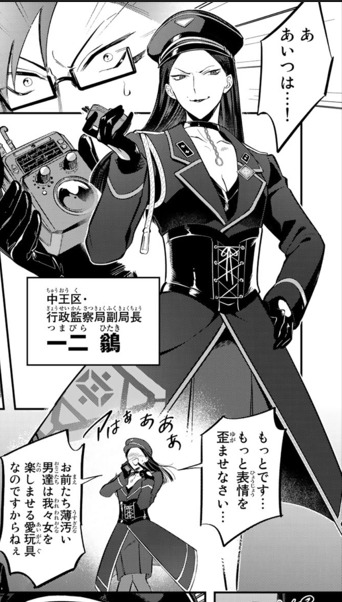
(BB/MTC+ chapter 4)
Compare the non-emphasis on the chest and the power stance to any of the many shots of Ichijuku where her breasts are front and center in the camera. Speaking of power stance, Tsumabira remains confident in her power stance without being sexy--that is, no stepping on the camera and showing her whole leg.
Which isn't to say that Tsumabira is a sexless character. She's drawn visibly turned on by the male characters in such a way that is cartoonish but not, in turn, overly sexual. Were this supposed to be titillating to the reader, I would have expected to see a larger close-up on her face and tongue. However, the artist (who is no stranger to focusing on tongues!) devotes the majority of the panel to Tsumabira's body language (which, again, doesn't absurdly exaggerate any of her proportions or focus on her chest) and covers part of the mouth with text bubbles. Tsumabira is drawn as engaging in sexual behavior without being sexualized for reader entertainment.
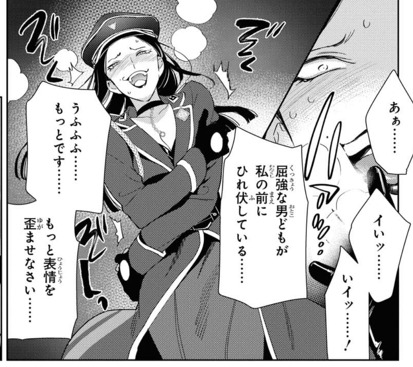
(FP/M+ chapter 4)
The juxtaposition of such different views with little to no judgement attached to any of them suggests that it's perfectly okay to want to be sexy or not, to wear revealing clothing or not, to be involved in sexual situations without being the object of sexual interest, or to simply exist with an attractive body type without sex ever coming into the equation. Just as some characters choose to tie bodies to sexiness, some don't whatsoever--and either is perfectly fine!
The former idea ("I can choose to be sexy") may not sound especially revolutionary to US audiences, where sexuality is thrust upon women willingly or otherwise, but I find it fascinating because it lets the main characters embrace this idea without associated slut shaming. So much of Japanese media insists that women should be sexy but are also wrong for wanting to indulge in their own sexuality. Therefore, having characters who run virtually every iteration of take on the topic (I want to engage in sexuality and be sexualized, I want to engage in sexuality without being sexualized, I don't want to engage in either) with multiple body types (ie, Tsumabira isn't automatically not sexualized because she has a smaller chest; Nemu isn't automatically sexualized because she has a bigger chest) and no judgement involved feels like another breath of fresh air to me.
As a whole, I find the diversity of the Chuuouku uniforms and character appearances quite interesting. They're undeniably all feminine and relatively militaristic, but different characters wear entirely different wardrobes. Skirts vs pants, blouses vs dresses, high heels vs boots... Since every character has her own take on the common theme, it once again feeds into the idea that each character is her own individual and perfectly valid for defining femininity in her own way.
Haircuts, too, range from longer and more feminine hairstyles to pixie cut-esque looks.

(BB/MTC+ chapter 16)
Again, nothing of the framing suggests this short-haired woman is in any way different from her longer-haired counterparts on the edges of this screenshot.
Finally, while most Chuuouku women are conventionally attractive, I find it extremely compelling that Haebaru is a stereotype of an unattractive Japanese woman. To be extremely clear, I do not think these stereotypes should have weight, but the combination of chubby and/or muscular build, freckles, rounded nose, and non-glossy hair is often used as a visual shorthand for unattractive or otherwise undesirable women.
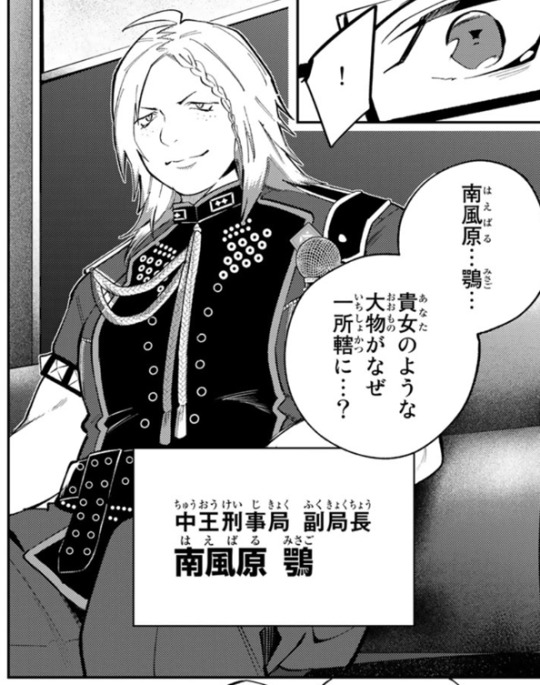
Sure, it's not fantastic that Haebaru is a scheming, two-bit villain. However, so is virtually every other female character in the series, and in particular, Haebaru is (the conventionally attractive) Tsumabira's counterpart. Both are treated with the same respect or lack thereof, suggesting that one's appearance has nothing to do with your ability to be a no-good baddie. Ha ha ha.
It would be lovely if the female characters were fleshed out further and given intelligent choices and diversity outside of the realms of physical appearance. However, I do think the writers' choices are limited by virtue of all women automatically being antagonistic side characters (which, again, is another discussion altogether). What the writers can and have accomplished is further reinforcing a celebration of differences. Just as there's no one right way to be a man, there's an infinite number of ways to be a scheming snake of a woman HAHA.
Intersection with LGBT+ Topics
Unfortunately, this is a very binary look at gender and gender roles, which, while largely representative of the current state of Japanese media, can be disappointing.
Hypmic appears to want to steer shy of LGBT+ topics as a whole, which is a bit of a shame. In a story so focused on gender and acceptance of diversity, it seems the natural next step to explore the notion of those who experiences don't align with a strict gender binary. Such stories are growing in popularity in Japanese media but have yet to be anywhere near the mainstream acceptance in US media (which is still in a fledgling stage at best). I would imagine Hypmic's writers are unable or unwilling to take a definite stance on these topics in the work due to fears of financial or career backlash. If nothing else, the sexuality of the main characters needs to remain in a limbo in order to have plausible deniability for both self-shipping and shipping with other characters. (Some deniability may be more plausible than others.)
The few instances in which Hypmic does wander into this territory are usually clumsy. I am no fan of the handful of scenes where male/male attraction is supposed to be funny purely by virtue of being male/male.
The inclusion of Urumi, the one minor character explicitly LGBT+, is not stellar either. I am hesitant to apply any definite label to her, as the real-life people her stereotype portrays self-identify as everything from trans women to cis men--or refuse to use these English labels at all! Still, we know from her profession (proprietor of a bar heavily implied to be a gay bar by the neighborhood it's in), appearance (poofy permed hair, exaggerated make-up), and demeanor (feminine speech style, a bit flirtatious) that she's AMAB and choosing to present herself in a feminine fashion. By writing Jirou to ask, "Aren't you a man?" in an exasperated fashion, the writers have put her gender presentation in a boke role--suggesting she's over-the-top, exaggerated, comedic. It's not great. I completely understand why readers find it offensive (and it is) even while I don't think the writers intended it that way. Ultimately, it would have been great to see other explicitly LGBT+ characters portrayed without the joking angle.
With that said, I'm not entirely unhappy with her character. She is a stereotype, but the authors have chosen to take only the visual elements of the stereotype and leave the rest on the cutting room floor. In other works of fiction, characters like Urumi are often hypersexual to the point of being in-universe creepy, especially towards underage boys. Other times, characters like her may be eccentric or off-putting in other ways. However, that's not at all the case here. Urumi seems to play a helpful big sister/aunt role in Jirou's life, and he's clearly comfortable enough with her to spend the night at her bar.
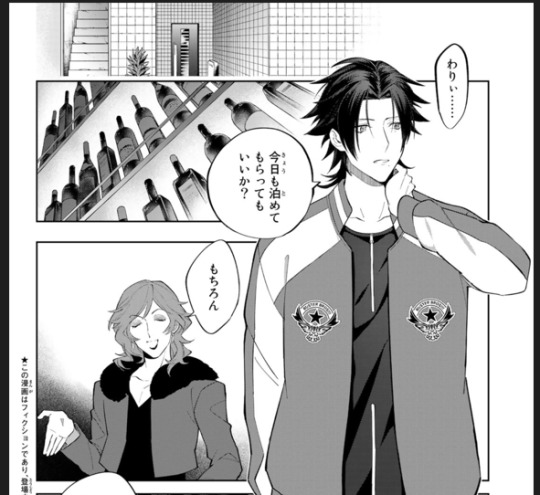
(BB/MTC+ chapter 17. "Sorry, but can I shack up here again tonight?" "Of course you can.")
While she seems to engage in some sort of a bohemian lifestyle, as evidenced by the alcohol and smoking, it isn't anything outside of what many of the other characters do. Additionally, while she isn't drawn in a flattering fashion in scenes where she's playing up her persona (which is par for the course with any character in this series, regardless of gender), there are plenty of neutral shots of her being serious. Finally, the art is never outright rude--that is, she isn't drawn exaggeratedly masculine or flamboyantly...snakey? I don't know how to describe this to anyone who's lucky enough to have never seen this--clearly LGBT+ AMAB characters drawn with noodly limbs and huge, overblown lips winding around male characters.
Maybe because I see so much worse continuing to be produced in this day and age, I feel like Hypmic could have done a much, much worse job with this character. She overall plays a positive role and is treated with much the same care as other side characters. It's unfortunate, then, that the writers have chosen to make her gender presentation the subject of a joke.
In other frustrations, I heavily dislike the unnecessary gender divide in background characters. All punks and other background baddies are male, whereas all adoring fans are female. (But Rhyme Anima has done an interesting job of subverting this!) The vast majority of other background figures fall into strict gender roles, which is likewise disappointing. It appears that diversity may be an accepted trait for none but a lucky few that form the main Hypmic cast.
All in all, I don't think Hypmic's portrayal of gender roles is groundbreaking, nor do I think it's fair to suggest that all Japanese pop culture plays into strict gender roles. There are certainly many Japanese works, popular or otherwise, with much more interesting things to say about gender. However, when compared to the vast majority of the titles that cross my desk on a regular basis, I notice and appreciate the level of care put in to Hypmic's commentary on gender roles. The work consistently reinforces the notion that it's okay to be your own individual, no matter how that plays into your gender, and I find that freeing. That's a message we could all do to hear more often, regardless of culture and language.
TL;DR: Oh no, my rapidly approaching deadline. :)
197 notes
·
View notes
Text
In a move that climatologists are calling "the dumbest thing I've heard since flat-Earthers started selling cruises," world leaders have unanimously agreed to ban clouds. Citing a "global vitamin D deficiency crisis" and a "concerning drop in sunglass sales," the international community has declared fluffy white menaces in the sky public enemy number one. "For too long, we've been held hostage by these tyrannical moisture moguls," declared a visibly tanned Prime Minister Boris Johnson during a press conference held poolside in his Downing Street backyard. "They block out the sun, our glorious, life-giving sun! It's time we took back control of our skies and embraced the eternal sunshine we deserve." Experts, meanwhile, are scratching their heads faster than a dandruff-stricken toupee in a hurricane. "Clouds play a vital role in regulating Earth's temperature and distributing precipitation," explained Dr. Penelope Nimbus, Director of the International Cloud Appreciation Society (ICAS), moments before being escorted out of the press conference by security guards. "Without them, well, let's just say things could get a little toasty." Undeterred by the concerns of pesky scientists, world leaders have outlined a series of ambitious (read: completely nonsensical) plans to eradicate clouds. Project "Sunbeam Supreme" involves a network of high-powered lasers stationed on mountaintops across the globe, ready to vaporize clouds into wispy memories. "Think of it like laser tag, but for clouds!" enthused a spokesperson for the project, conveniently leaving out any mention of potential collateral damage like vaporized airplanes or rogue laser beams melting ice cream trucks. For those who prefer a less "death ray" approach, there's Project "Cloud Chowdown." This initiative focuses on the development of gigantic, cloud-eating machines, essentially industrial-sized air purifiers with a taste for cotton candy. "It's still in the prototype phase," admitted a sheepish engineer, "but we're confident it won't look anything like that terrifying пылесос (pylesos - Russian for vacuum cleaner) from that old Soviet cartoon." Perhaps the most ludicrous proposal comes from the newly formed International Cloud Patrol (ICP). This elite squad of weather warriors, armed with jetpacks and high-tech cloud zappers, will patrol the skies, taking down rogue cumulus and nimbus formations before they have a chance to cast a shadow. "We're basically the Avengers of the atmosphere," boasted Captain Skybolt, leader of the ICP, before tripping over his jetpack and face-planting into a pile of conference room canapés. The public reaction to the cloud ban has been, well, mixed. Protests erupted in major cities around the world, with citizens chanting "Let the clouds be!" and "Sunscreen is our friend!" Meanwhile, resourceful entrepreneurs are capitalizing on the black market for illegal clouds. "Business is booming," said a shady figure in a trench coat, hawking vials of "artisanal cirrocumulus" in a back alley. "People are desperate for a little shade, a touch of mystery. Who wants to live in an endless, sterile blue void?" In the midst of this meteorological madness, one thing remains clear: the world's leaders have completely lost their marbles. But hey, at least they'll all have a killer tan by the time this whole thing inevitably falls apart. So, the next time you look up at a fluffy cloud formation, remember – it's not just a puff of water vapor. It's a symbol of freedom, of the delicate balance of our planet, and of course, a reminder that sometimes, even the most powerful people in the world can be as clueless as a weatherman predicting sunshine during a hurricane. #climateaction #cloudban #environment #globalwarming #news #Satire
0 notes
Text
0 notes
Text
Vacuum Truck Market, Size, Global Forecast 2024-2032, Industry Trends, Share, Growth, Insight, Impact of Inflation, Company Analysis
The vacuum truck market has grown and become more diverse in recent years. These flexible vehicles are discovered in lots of industries, like manufacturing, where they do important jobs. They clean gutters, sanitize sewers, collect stormwater, and competently take care of substances all through hydro excavation.
0 notes
Text
Aluminum Target Market Value, Growth, and Trends

Advance Market Analytics published a new research publication on "Aluminum Target Market Insights, to 2028" with 232 pages and enriched with self-explained Tables and charts in presentable format. In the Study you will find new evolving Trends, Drivers, Restraints, Opportunities generated by targeting market associated stakeholders. The growth of the Aluminum Target market was mainly driven by the increasing R&D spending across the world.
Get Free Exclusive PDF Sample Copy of This Research @ https://www.advancemarketanalytics.com/sample-report/1601-global-aluminum-target-market-1 Some of the key players profiled in the study are: E-light (United Kingdom), Lesker (United States), Beijing Scistar Technology (China), Kaize Metals (India), Beijing Guanli (China), ZNXC (China). Scope of the Report of Aluminum Target Aluminum Target market is expected to mark significant growth over forecasted period owing to increasing consumers spending on passenger vehicles, passenger vehicles and others applications and technological advancement. Aluminum Target allows users to generate an eco-friendly, efficient and cost-effective provide output. This result in rising popularity of commercial activities and escalating need for commercial applications may trigger demand and help in industry expansion. The titled segments and sub-section of the market are illuminated below: by Type (Plane Target, Rotating  Target), Application (Microelectronics, Monitor, Storage, Other) Market Trends: Increasing demand at Asia-Pacific region.
Opportunities: Better performance against chemical attack.
Upsurge Demand of aluminum target that used for vacuum deposition and electroplating.
Market Drivers: Increase demand of aluminum target in passenger vehicles and commercials trucks.
Rapid Demand of aluminum target due to eco-friendly, efficient and cost-effective in nature.
Region Included are: North America, Europe, Asia Pacific, Oceania, South America, Middle East & Africa Country Level Break-Up: United States, Canada, Mexico, Brazil, Argentina, Colombia, Chile, South Africa, Nigeria, Tunisia, Morocco, Germany, United Kingdom (UK), the Netherlands, Spain, Italy, Belgium, Austria, Turkey, Russia, France, Poland, Israel, United Arab Emirates, Qatar, Saudi Arabia, China, Japan, Taiwan, South Korea, Singapore, India, Australia and New Zealand etc. Have Any Questions Regarding Global Aluminum Target Market Report, Ask Our Experts@ https://www.advancemarketanalytics.com/enquiry-before-buy/1601-global-aluminum-target-market-1 Strategic Points Covered in Table of Content of Global Aluminum Target Market:
Chapter 1: Introduction, market driving force product Objective of Study and Research Scope the Aluminum Target market
Chapter 2: Exclusive Summary – the basic information of the Aluminum Target Market.
Chapter 3: Displayingthe Market Dynamics- Drivers, Trends and Challenges & Opportunities of the Aluminum Target
Chapter 4: Presenting the Aluminum Target Market Factor Analysis, Porters Five Forces, Supply/Value Chain, PESTEL analysis, Market Entropy, Patent/Trademark Analysis.
Chapter 5: Displaying the by Type, End User and Region/Country 2015-2020
Chapter 6: Evaluating the leading manufacturers of the Aluminum Target market which consists of its Competitive Landscape, Peer Group Analysis, BCG Matrix & Company Profile
Chapter 7: To evaluate the market by segments, by countries and by Manufacturers/Company with revenue share and sales by key countries in these various regions (2023-2028)
Chapter 8 & 9: Displaying the Appendix, Methodology and Data Source finally, Aluminum Target Market is a valuable source of guidance for individuals and companies. Read Detailed Index of full Research Study at @ https://www.advancemarketanalytics.com/reports/1601-global-aluminum-target-market-1 Thanks for reading this article; you can also get individual chapter wise section or region wise report version like North America, Middle East, Africa, Europe or LATAM, Southeast Asia. Contact US : Craig Francis (PR & Marketing Manager) AMA Research & Media LLP Unit No. 429, Parsonage Road Edison, NJ New Jersey USA – 08837 Phone: +1 201 565 3262, +44 161 818 8166 [email protected]
#Global Aluminum Target Market#Aluminum Target Market Demand#Aluminum Target Market Trends#Aluminum Target Market Analysis#Aluminum Target Market Growth#Aluminum Target Market Share#Aluminum Target Market Forecast#Aluminum Target Market Challenges
0 notes
Text
Regional Outlook of the Cryogenic Tanks Market: Trends and Forecast

The cryogenic tanks market has been growing significantly over the past decade owing to the increasing demand and consumption of liquefied natural gas globally. Cryogenic tanks are specifically designed storage vessels used for storing liquefied gases at temperatures lower than -150 degree Celsius. The main liquefied gases stored using cryogenic tanks include liquefied natural gas (LNG), oxygen, nitrogen, argon, and liquefied hydrogen. Cryogenic tanks provide an efficient, safe and economical solution for storage and transport of liquefied gases over long distances via ships, railcars or trucks. The burgeoning LNG industry has been the primary growth driver for cryogenic tanks considering its increasing usage in power generation, industrial processes and transportation fuel. The Global Cryogenic Tanks Market is estimated to be valued at US$ 6.51 Bn in 2024 and is expected to exhibit a CAGR of 5.0% over the forecast period 2023 to 2030. Key Takeaways
Key players operating in the cryogenic tanks are ArcelorMittal, China Baowu Group, Nippon Steel Corporation, POSCO, Shagang Group, Ansteel Group, Glencore, Sumitomo Metal Mining Company, Linde, INOX India Pvt., Cryofab, FIBA Technologies, Air Products and Chemicals, Inc., M1 Engineering, Chart Industries, Wessington Cryogenics, Isisan, Lapesa, Auguste Cryogenics, and Hoover Ferguson Group, Inc.. Key players are focusing on capacity expansions and investments in research and development to develop improved and more durable cryogenic tank materials. The growing demand for LNG as a cleaner alternative fuel for power generation and transportation has been driving increased consumption of cryogenic tanks globally. Countries like China and India have emerged as high growth markets for LNG and cryogenic storage infrastructure. Technological advancements in cryogenic tank materials including 9% nickel steels and composite materials have enhanced durability and reduced maintenance costs of cryogenic storage and transportation systems. Development of vacuum insulated and modular cryogenic tank designs have also optimized storage capacity. Market Trends
Thinner tank walls: Tank manufacturing companies are developing tank designs with thinner and lighter tank walls through advanced material engineering while maintaining required strength and integrity at cryogenic temperatures.
Modular construction: Modular construction techniques allow cryogenic tanks to be assembled on-site with pre-fabricated sections reducing construction timelines significantly. This helps meet the rapidly growing demand. Market Opportunities
Reusable cryogenic tanks: There is scope for reusable cryogenic tank designs that can be returned, refilled and redeployed to improve cost efficiencies over the life cycle. On-site storage: With growing decentralized energy needs, there exists opportunities for scaled-down on-site stationary cryogenic storage for industrial applications. Impact of COVID-19 on Cryogenic Tanks Market
The outbreak of the COVID-19 pandemic had a significant impact on the growth of the cryogenic tanks market initially. During the lockdown period of 2020-2021, production facilities and manufacturing plants were temporarily shut down due to strict social distancing norms. This led to disruptions in the supply chain and a drop in demand across end-use industries such as oil & gas, metallurgy, power generation and others which use cryogenic tanks. However, with vaccination drives and easing of lockdowns from mid-2021, production and supply chain activities have resumed while following necessary safety protocols. The demand from power generation and healthcare sectors increased significantly driven by the need for medical oxygen which boosting the cryogenic tanks market again. Going forward, the pandemic has highlighted the need for reliable and flexible gas supply infrastructure which is expected to drive investments towards building new liquefaction plants and expanding gas transportation facilities using cryogenic tanks. Geographical Regions with High Concentration in Cryogenic Tanks Market
Asia Pacific region dominates the global cryogenic tanks market in terms of value owing to high demand from China, India and other developing countries. This is attributed to rapid industrialization, growing demand for LNG and medical oxygen along with government initiatives towards gas-based economy and clean energy. North America is the second largest market for cryogenic tanks driven by increasing production of shale gas and its transportation/storage requirements in the region. Europe also holds significant share in the market supported by ongoing energy transition initiatives towards replacing coal/oil with cleaner natural gas and hydrogen. Fastest Growing Region for Cryogenic Tanks Market
Asia Pacific region is projected to be the fastest growing market for cryogenic tanks during the forecast period of 2023-2030. This is because majority of planned investments and capacity addition of gas liquefaction, regasification and gas-based power plants are concentrated in emerging economies of China, India and ASEAN countries. Additionally, rising LNG trade activities between Asia and other regions increases the requirements for tanker transportation of gas using cryogenic technology. Government policies supporting gas utilization over other fuels as well as expanding industrialization will further augment the demand for cryogenic tanks from various end-use industries in Asia Pacific.
0 notes
Text
0 notes
Text
Understanding Different Types of Hydraulic Pumps
Understanding Different Types of Hydraulic Pumps – Hydraulic pumps are essential tools widely utilized across different sectors. These devices find applications in various industrial and mobile hydraulic machinery, ranging from cranes and tractors to loaders and vacuum trucks. Given their versatility, hydraulic pumps are a mainstay in mining, vehicle manufacturing, oil and gas, forestry, marine, agriculture, and construction. It’s no wonder that according to Technavio, the global hydraulic pump market is projected to witness a considerable growth of $3.53 billion (£2.82 billion) between 2021 and 2026.

One can say that hydraulic pumps are the beating heart of hydraulic systems. The primary role of a hydraulic pump is to convert mechanical energy into hydraulic energy, characterized by a blend of flow and pressure. Essentially, any device that can be manipulated to create force and generate pressure, resulting in flow, qualifies as a hydraulic pump.
Different Types of Hydraulic Pumps
The world of hydraulic pumps encompasses three fundamental types:
Gear
Piston
Vane pumps.
These pump classifications further branch into distinct subcategories, such as fixed and variable displacement pump types.
Powered by Electricity
Electrically driven hydraulic pumps are powered by electric motors, serving as vital energy sources for hydraulic systems. Modern electric pumps are particularly effective for smaller to medium-sized hydraulic tools, making them ideal for applications necessitating convenient pump mobility.
Manual Operation with Hydraulic Hand Pumps
Hydraulic hand pumps operate through manual force exerted on an actuator, propelling the fluid. This actuator can be a handle, lever, or toggle. Hydraulic hand pumps find utility in various applications, including water pumping and hydraulic fluid distribution.
Air-Driven Hydraulic Pumps
Air hydraulic or pneumatic hydraulic pumps utilize compressed air to initiate pump action, converting pressurized liquids into energy. These pumps play a vital role across multiple industries, facilitating the lifting of heavy loads and transporting materials with reduced initial force.
Portable Cordless Battery-Powered
Hydraulic Pumps High-pressure cordless battery-powered hydraulic pumps are prized for their safety, speed, and portability. They prove invaluable in remote settings lacking power sources, ensuring efficiency and convenience. These cordless pumps find application indoors, especially when prioritizing size, minimizing trip hazards, and optimizing’s ergonomics.
Constant Output Pumps
A constant-output pump belongs to the positive displacement category, exhibiting an unalterable displacement volume due to the absence of control mechanisms. This type maintains a steady flow rate, ensuring that each motor stroke propels the same quantity of fluid. Constant output pumps boast straightforward maintenance, cost-effectiveness, and simplicity, making them a preferred choice. These pumps find application in hydraulic systems with an open Centre. Among them, the gear pump stands as the most uncomplicated fixed-displacement pump. Rotating gears drive the hydraulic gears in this pump, with the gears interlocking for enhanced efficiency. Another notable variation is the screw pump, leveraging the renowned Archimedes screw to mobilise the fluid. Fixed displacement pumps are renowned for their capacity to deliver a high flow rate at relatively low pressure.
Adaptable Output Pumps
Adaptable output pumps effectively transform mechanical energy into hydraulic energy, and their hydraulic flow needs can vary depending on the operational circumstances. Unlike fixed displacement pumps, the swashplate of an adaptable output pump is adjustable, allowing for alteration based on pressure cues. Modifying the swashplate angle enables the pump to accommodate increased flow demands, resulting in an elongated piston stroke that augments pump displacement. These pumps find application in closed-Centre systems, functioning differently from their fixed displacement counterparts. In a closed Centre system, the swashplate angle of the adaptable output pump diminishes when the demand for flow decreases, preventing surplus flow or loss of hydraulic power.
Cogwheel Pumps
Cogwheel pumps are one of the most straightforward and prevalent hydraulic pump varieties today. They fall under the positive displacement pumps category, specifically fixed displacement pumps. Within this pump, fluid is propelled by containing a set fluid volume using intermeshed gears and then transferring it as the gears revolve. Typically, a gear pump comprises two gears: the driving gear, connected to a mechanical power source or prime movers, and the driven gear, which remains idle. The output of a gear pump yields a steady flow directly proportionate to the rotational speed of the gears. This pump type is predominantly deployed for generating high pressure.
These pumps find application in hydraulic systems with an open-Centre configuration. They confine oil in the spaces amid the pump’s body and the teeth of its two gears, circulating it around the gear cavity’s periphery and propelling it through the exit port upon gear meshing. A minute quantity of pressurized oil behind the wear plates pushes it firmly against the ends of the gear, enhancing pump efficiency. Gear pumps are commonly assessed based on the pump’s maximum input speed restriction, highest pressure tolerance, and cubic inch displacement. Moreover, the swept volume for hydraulic gear pumps typically ranges between 1 to 200 millimetres. An intriguing detail about gear pumps is that their volumetric efficiency ranks lower than the other primary pump types.
Benefits of Gear Pump
Simplicity and compactness with minimal moving components
Cost-effective solution
Low maintenance expenses
Capable of generating high pressures (up to 3000 psi)
Effective for pumping viscous liquids like oils with minimal leakage risk
Operate in both directions, suitable for loading and unloading
Resilient to contamination
Challenges with Gear Pumps
Known for producing noticeable noise during operation.
Limited range of sizes, rendering them unsuitable for substantial bulk flow rates.
Not compatible with abrasive fluids due to the use of meshing gears.
0 notes
Text
Global Die Casting Market Is Estimated To Witness High Growth Owing To Increasing Demand from Automotive and Aerospace Industries

The global Die Casting Market is estimated to be valued at US$ 77.99 Bn in 2023 and is expected to exhibit a CAGR of 6.24% over the forecast period 2023-2028, as highlighted in a new report published by Coherent Market Insights.
A) Market Overview:
The die casting market involves the production of complex metal parts through the process of forcing molten metal under high pressure into reusable molds. The die casting process offers several benefits, including high dimensional accuracy, smooth surface finish, and the ability to produce intricate shapes. Die casting finds extensive applications in industries such as automotive, aerospace, consumer goods, electrical and electronics, and healthcare. The automotive and aerospace industries are the major drivers for the growth of the die casting market, owing to the increasing demand for lightweight and fuel-efficient vehicles and aircraft.
B) Market Dynamics:
Two major drivers for the growth of the die casting market are:
1. Growing Automotive Industry: The automotive industry is witnessing significant growth globally, with consumers demanding fuel-efficient and lightweight vehicles. Die castings are extensively used in automotive parts manufacturing due to their high strength, durability, and cost-effectiveness. Moreover, advancements in die casting technologies, such as vacuum-assisted high-pressure die casting (HPDC), have further increased the demand for die castings in the automotive industry.
2. Increasing Demand from Aerospace Industry: The aerospace industry is witnessing substantial growth due to rising air travel demand and increasing defense expenditure worldwide. Die castings are widely used in manufacturing aircraft components such as engine parts, wing frames, and structural components. The use of die castings in the aerospace industry helps in reducing weight, enhancing fuel efficiency, and improving overall aircraft performance.
C) Market Key Trends:
One key trend observed in the Die Casting Market is the increasing adoption of aluminum die castings. Aluminum is the most commonly used material in die casting due to its lightweight, excellent strength-to-weight ratio, and high thermal and electrical conductivity. The automotive industry is the major consumer of aluminum die castings, where they are used in engine components, transmission housings, wheels, and other structural parts. For instance, the Ford F-150 series of trucks extensively utilize aluminum die castings in their construction to reduce weight and improve fuel efficiency.
D) SWOT Analysis:
Strengths:
1. High dimensional accuracy: Die castings offer high dimensional accuracy, ensuring precise fit and assembly of parts.
2. Cost-effective production: The die casting process allows for mass production of complex parts at a lower cost compared to other manufacturing processes.
Weaknesses:
1. Limited flexibility in design changes: Once a die is created, any design changes become costly and challenging to implement.
2. Environmental impact: The die casting process produces significant amounts of waste and can have negative environmental implications if proper measures are not taken for waste management and recycling.
Opportunities:
1. Growing demand from emerging economies: The increasing industrialization and infrastructural development in emerging economies present significant opportunities for the die casting market.
2. Adoption of lightweight materials: The demand for lightweight materials in various industries, such as automotive and aerospace, provides opportunities for the use of die castings.
Threats:
1. Intense competition from alternative manufacturing processes: Other manufacturing processes such as 3D printing and CNC machining pose a threat to the die casting market.
2. Fluctuating raw material costs: The prices of raw materials used in die castings, such as aluminum, zinc, and magnesium, are subject to market fluctuations.
E) Key Takeaways:
- The global die casting market is expected to witness high growth, exhibiting a CAGR of 6.24% over the forecast period, due to increasing demand from the automotive and aerospace industries.
- The Asia-Pacific region is expected to be the fastest growing and dominating region in the die casting market, owing to rapid industrialization, growing automotive production, and increasing investments in aerospace and defense sectors.
- Key players operating in the global die casting market include Alcast Technologies, Arconic, Consolidated Metco, Inc., Dynacast International Inc., Gibbs Die Casting, Ryobi Die Casting Inc., Bodine Aluminum, and Martinrea.
#Die Casting#Die Casting Market Size#Die Casting Market Share#Die Casting Market Insights#Information and Communication Technology
0 notes
Text
Railroad Equipment Market Analysis, Size, Growth, Competitive Strategies, and Worldwide Demand
Global Railroad Equipment Market Report from AMA Research highlights deep analysis on market characteristics, sizing, estimates and growth by segmentation, regional breakdowns & country along with competitive landscape, player’s market shares, and strategies that are key in the market. The exploration provides a 360° view and insights, highlighting major outcomes of the industry. These insights help the business decision-makers to formulate better business plans and make informed decisions to improved profitability. In addition, the study helps venture or private players in understanding the companies in more detail to make better informed decisions. Major Players in This Report Include EMD (United States),Siemens (Germany),Wabtec (United States),American Railcar Industries (United States),GE (United States),Greenbrier (United States),Progressive Rail Locomotive (United States),Trinity Industries (United States),ALSTOM (France),Bombardier (Canada),CRRC Corporation (China),NIPPON SHARYO (Japan)
The railroad equipment is the equipment that supports railroad projects. In this many equipments are involved in the category used for multiple types of work. In railroads, projects require highly specialized equipment, engineers and other unique services to perform railroad services. This market growth depends on the demand for the rail industry. Market Drivers Rise in Demand of Public Transport by the Government
Increasing Demand for Comfort Zone While Travelling
The Growing Number of Trains Worldwide
Increasing Disposable Income of People
Market Trend Increase in the Number of Passengers Using Railways
The Rapid Adoption of IoT and Safety in Railways
Rising Demand for Scrap Produced During Steel Making
Opportunities Increasing Construction Activities and Infrastructure in the Asia-Pacific Region
Challenges High Initial Cost Investment in Railways The Railroad Equipment market study is being classified by Application (Railway, Subway, Others), Equipment (Caterpillar Sideboom, Caterpillar Track Loader, Caterpillar Wheel Loader, Caterpillar Excavator / Track Hoe, Hi-Rail Crane, Locomotive Service Truck (LST), Hi-Rail Vacuum Truck, Caterpillar Dozer, Dozer Rake, Caterpillar Backhoe, Dump Truck, Others) Presented By
AMA Research & Media LLP
0 notes
Text
The global vacuum truck market size reached US$ 1.8 Billion in 2022. Looking forward, IMARC Group expects the market to reach US$ 2.7 Billion by 2028, exhibiting a growth rate (CAGR) of 6.78% during 2023-2028.
1 note
·
View note
Text
0 notes
Text
0 notes
Link
0 notes